Design and Multi-Objective Optimization of a Composite Cage Rotor Bearingless Induction Motor
Abstract
1. Introduction
2. Topology and Mathematical Model of the CCR-BIM
2.1. Topology of the CCR-BIM
2.2. Mathematical Model of the CCR-BIM
2.2.1. Suspension Force Model
2.2.2. Torque Model of the CCR-BIM
3. Motor Optimization
3.1. Structure Parameter Setting
3.2. Optimization Objectives
3.3. Design of the Multi-objective Optimization
3.3.1. Sensitivity Analysis
3.3.2. Optimization of the Parameters
RSM
Optimization Design Based on the Improved NSGA-II
4. Experimental Verification
5. Conclusions
Author Contributions
Funding
Data Availability Statement
Conflicts of Interest
References
- Zhu, H.; Li, H. Magnetic Field Equivalent Current Analysis-Based Radial Force Control for Bearingless Permanent Magnet Synchronous Motors. Energies 2015, 8, 4920–4942. [Google Scholar] [CrossRef]
- Noh, M.; Trumper, D.L. Homopolar Bearingless Slice Motor With Flux-Biasing Halbach Arrays. IEEE Trans. Ind. Electron. 2019, 67, 7757–7766. [Google Scholar] [CrossRef] [PubMed]
- Yang, Z.; Jia, J.; Sun, X.; Xu, T. An Enhanced Linear ADRC Strategy for a Bearingless Induction Motor. IEEE Trans. Transp. Electrif. 2021, 8, 1255–1266. [Google Scholar] [CrossRef]
- Mousavi G, S.M.; Faraji, F.; Majazi, A.; Al-Haddad, K. A comprehensive review of Flywheel Energy Storage System technology. Renew. Sustain. Energy Rev. 2017, 67, 477–490. [Google Scholar] [CrossRef]
- Ding, Q.; Yang, Z.; Sun, X.; Zhao, Q.; Zhu, H. Analysis of rotor slot width influence on a bearingless induction motor. Comput. Electr. Eng. 2019, 81, 106534. [Google Scholar] [CrossRef]
- Chiba, A.; Fukao, T. Optimal design of rotor circuits in induction type bearingless motors. IEEE Trans. Magn. 1998, 34, 2108–2110. [Google Scholar] [CrossRef]
- Sun, Y.; Tang, J.; Shi, K. Design of a Bearingless Outer Rotor Induction Motor. Energies 2017, 10, 705. [Google Scholar] [CrossRef]
- Hua, Y.; Zhu, H.; Xu, Y. Multi-Objective Optimization Design of Bearingless Permanent Magnet Synchronous Generator. IEEE Trans. Appl. Supercond. 2020, 30, 5201205. [Google Scholar] [CrossRef]
- Huang, C.; Kou, B.; Zhao, X.; Niu, X.; Zhang, L. Multi-Objective Optimization Design of a Stator Coreless Multidisc Axial Flux Permanent Magnet Motor. Energies 2022, 15, 4810. [Google Scholar] [CrossRef]
- Ilka, R.; Alinejad-Beromi, Y.; Yaghobi, H. Cogging torque reduction of permanent magnet synchronous motor using multi-objective optimization. Math. Comput. Simul. 2018, 153, 83–95. [Google Scholar] [CrossRef]
- Si, J.; Yan, Z.; Nie, R.; Li, Z.; Hu, Y.; Li, Y. Multi-objective optimization of a tubular permanent magnet linear generator with 120° phase belt toroidal windings using response surface method and genetic algorithm. IET Renew. Power Gener. 2021, 16, 352–361. [Google Scholar] [CrossRef]
- Jiang, R.; Jin, Z.; Liu, D.; Wang, D. Multi-Objective Lightweight Optimization of Parameterized Suspension Components Based on NSGA-II Algorithm Coupling with Surrogate Model. Machines 2021, 9, 107. [Google Scholar] [CrossRef]
- Sharifi, M.; Mojallali, H. Multi-Objective Modified Imperialist Competitive Algorithm for Brushless DC Motor Optimization. IETE J. Res. 2017, 65, 96–103. [Google Scholar] [CrossRef]
- Yang, Z.; Ji, J.; Sun, X.; Zhu, H.; Zhao, Q. Active Disturbance Rejection Control for Bearingless Induction Motor Based on Hyperbolic Tangent Tracking Differentiator. IEEE J. Emerg. Sel. Top. Power Electron. 2019, 8, 2623–2633. [Google Scholar] [CrossRef]
- Lu, C.; Yang, Z.; Sun, X.; Ding, Q.; Zhao, Q. A decoupling control of composite cage rotor bearingless induction motor based on SA-PSO support vector machine inverse. Int. Trans. Electr. Energy Syst. 2021, 31, e12988. [Google Scholar] [CrossRef]
- Chen, S. Motor Design; China Machine Press: Beijing, China, 2000; pp. 9–18. [Google Scholar]
- Zhu, H.; Shen, S.; Wang, X. Multiobjective Optimization Design of Outer Rotor Coreless Bearingless Permanent Magnet Synchronous Motor. IEEE J. Emerg. Sel. Top. Power Electron. 2021, 9, 5489–5498. [Google Scholar] [CrossRef]
- Gieras, J.F.; Saari, J. Performance Calculation for a High-Speed Solid-Rotor Induction Motor. IEEE Trans. Ind. Electron. 2011, 59, 2689–2700. [Google Scholar] [CrossRef]
- Andriushchenko, E.; Kallaste, A.; Mohammadi, M.H.; Lowther, D.A.; Heidari, H. Sensitivity Analysis for Multi-Objective Optimization of Switched Reluctance Motors. Machines 2022, 10, 559. [Google Scholar] [CrossRef]
- Mahmouditabar, F.; Vahedi, A.; Mosavi, M.R.; Bafghi, M.H.B. Sensitivity analysis and multiobjective design optimization of flux switching permanent magnet motor using MLP-ANN modeling and NSGA-II algorithm. Int. Trans. Electr. Energy Syst. 2020, 30, e12511. [Google Scholar] [CrossRef]
- Zhu, Z.; Zhu, J.; Zhu, H.; Zhu, X.; Yu, Y. Optimization Design of an Axial Split-Phase Bearingless Flywheel Machine with Magnetic Sleeve and Pole-Shoe Tooth by RSM and DE Algorithm. Energies 2020, 13, 1256. [Google Scholar] [CrossRef]
- Nguyen, H.L.; Duy, L.T. Using the Box–Behnken Response Surface Method to Study Parametric Influence to Improve the Efficiency of Helical Gears. Machines 2021, 9, 264. [Google Scholar] [CrossRef]
- Liu, G.; Wang, Y.; Chen, Q.; Xu, G.; Song, C. Multiobjective Deterministic and Robust Optimization Design of a New Spoke-Type Permanent Magnet Machine for the Improvement of Torque Performance. IEEE Trans. Ind. Electron. 2020, 67, 10202–10212. [Google Scholar] [CrossRef]
- Suzuki, T.; Chiba, A.; Rahman, M.A.; Fukao, T. An air-gap-flux-oriented vector controller for stable operation of bearingless induction motors. IEEE Trans. Ind. Appl. 2000, 36, 1069–1076. [Google Scholar] [CrossRef]
- Bu, W.; Cheng, X.; He, F.; Qiao, Y.; Zhang, H.; Xu, X. Inverse system modeling and decoupling control of bearingless induction motor based on air gap flux orientation. Int. J. Appl. Electromagn. Mech. 2017, 53, 567–577. [Google Scholar] [CrossRef]
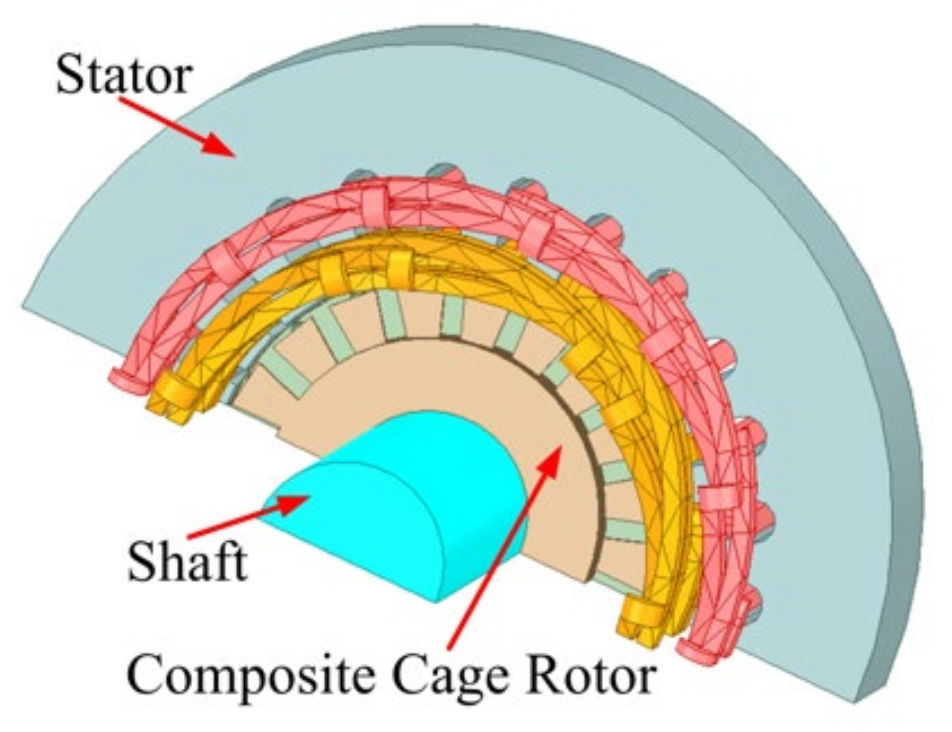
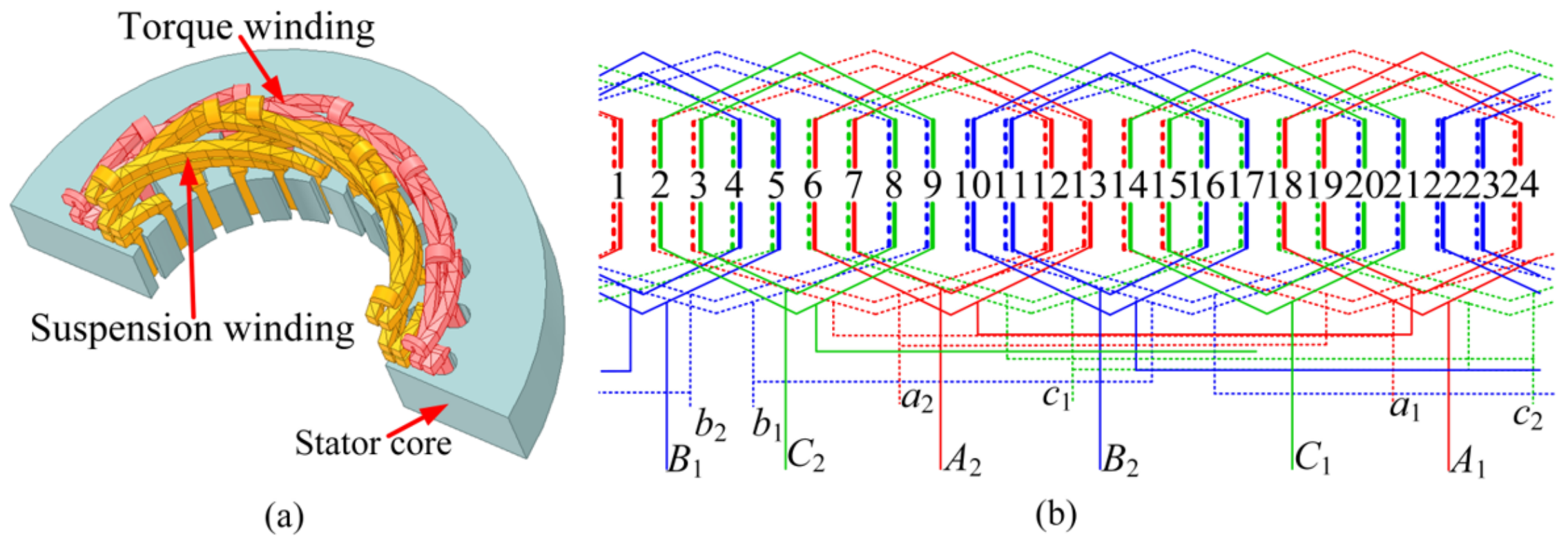
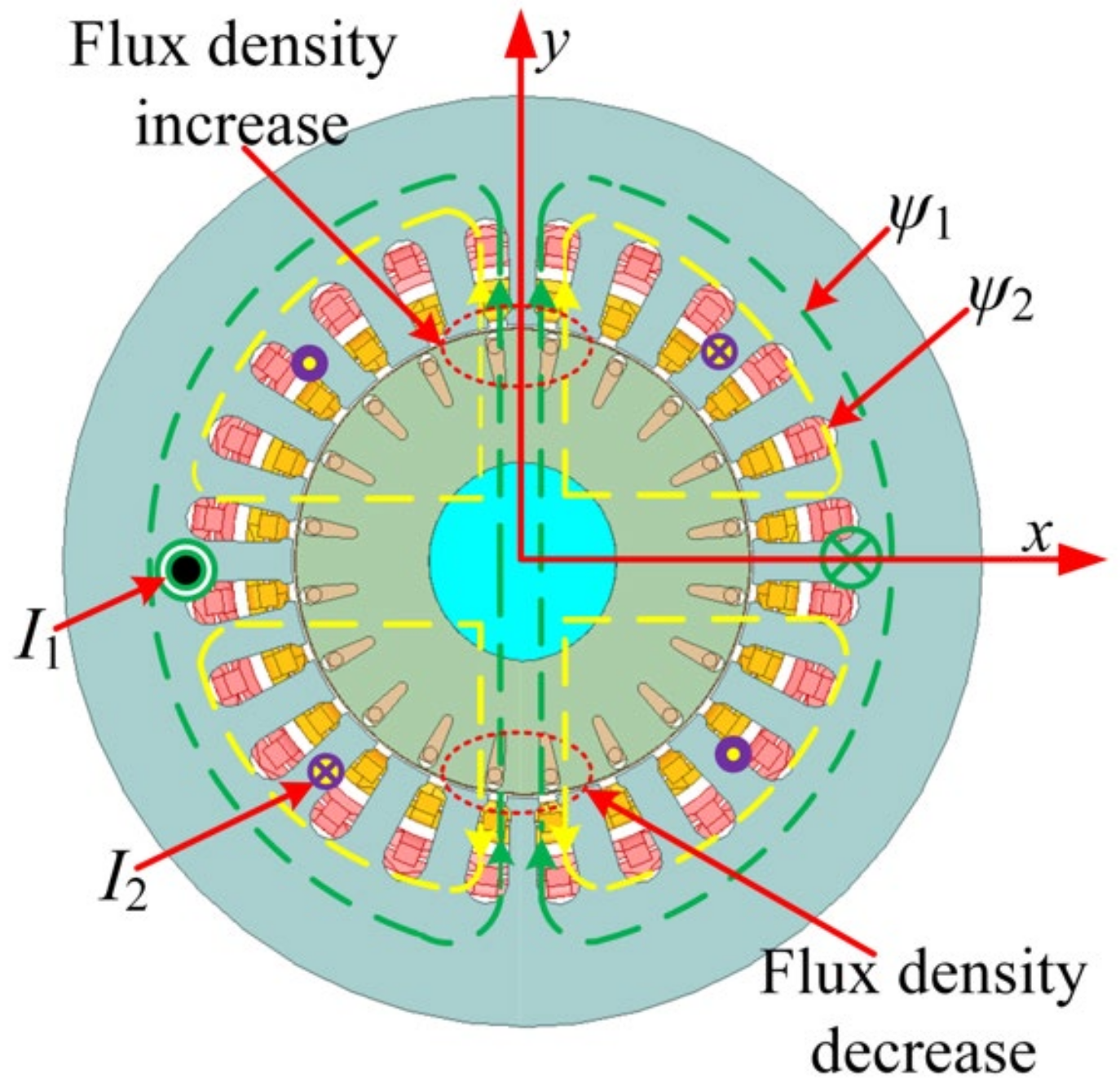

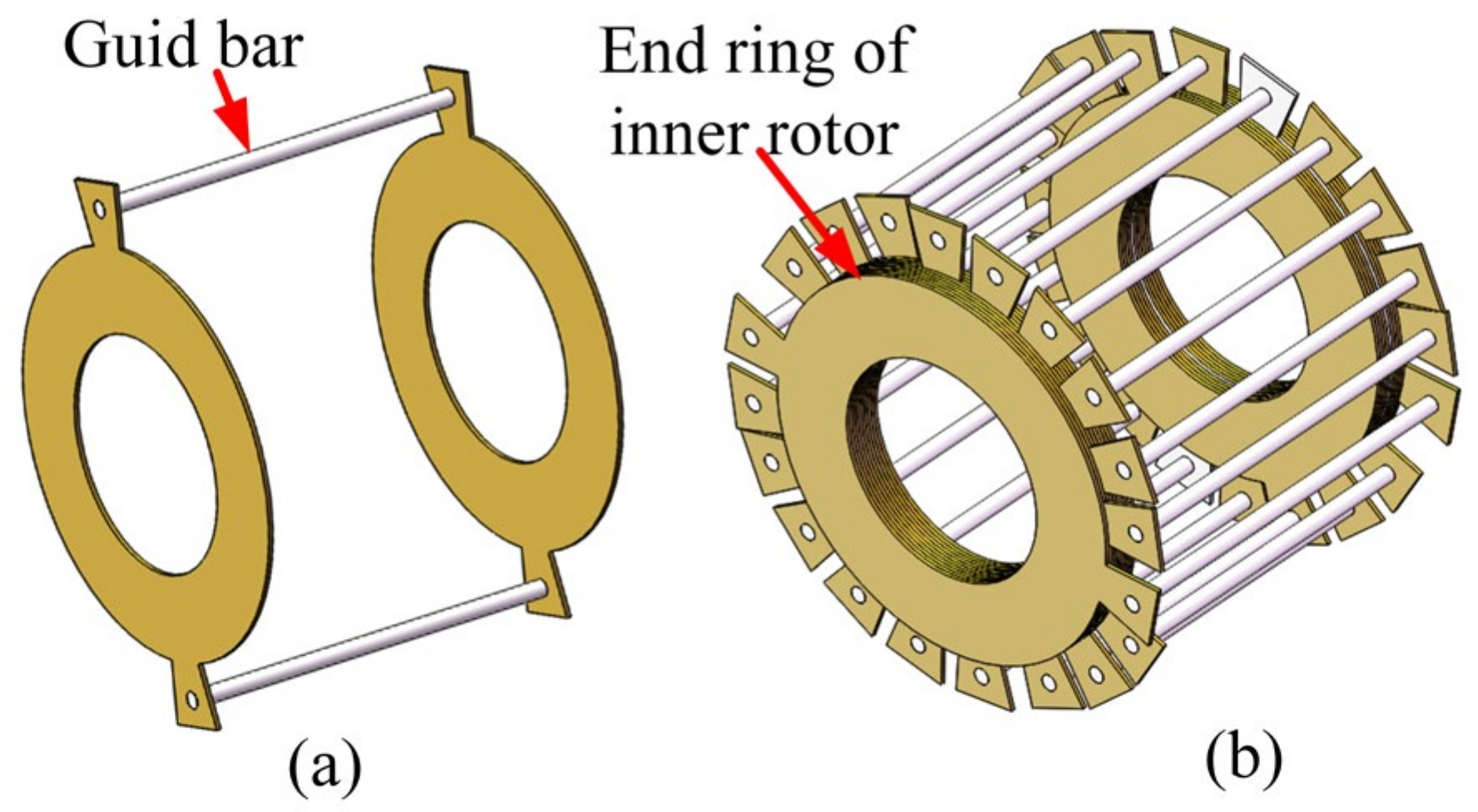
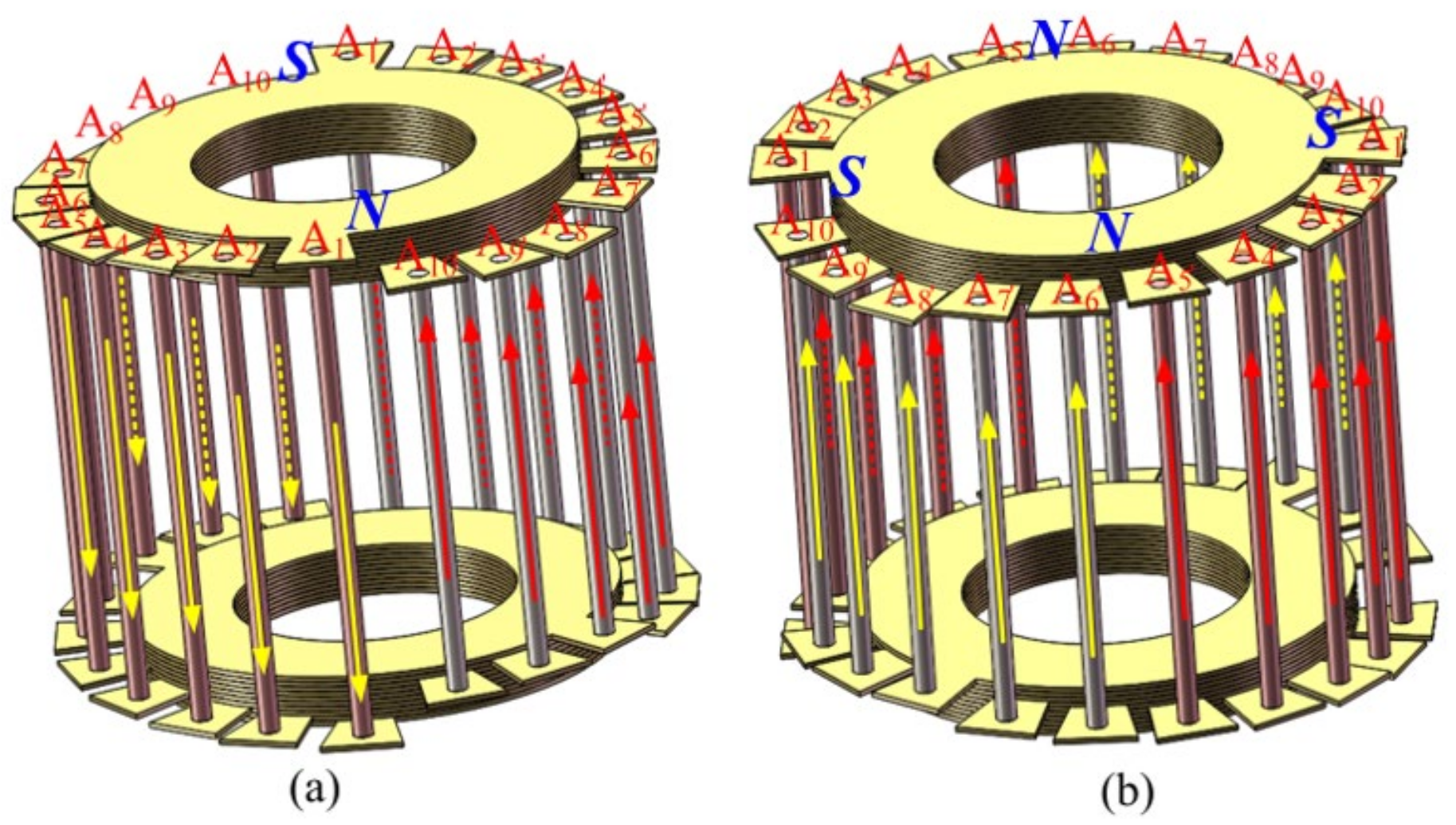
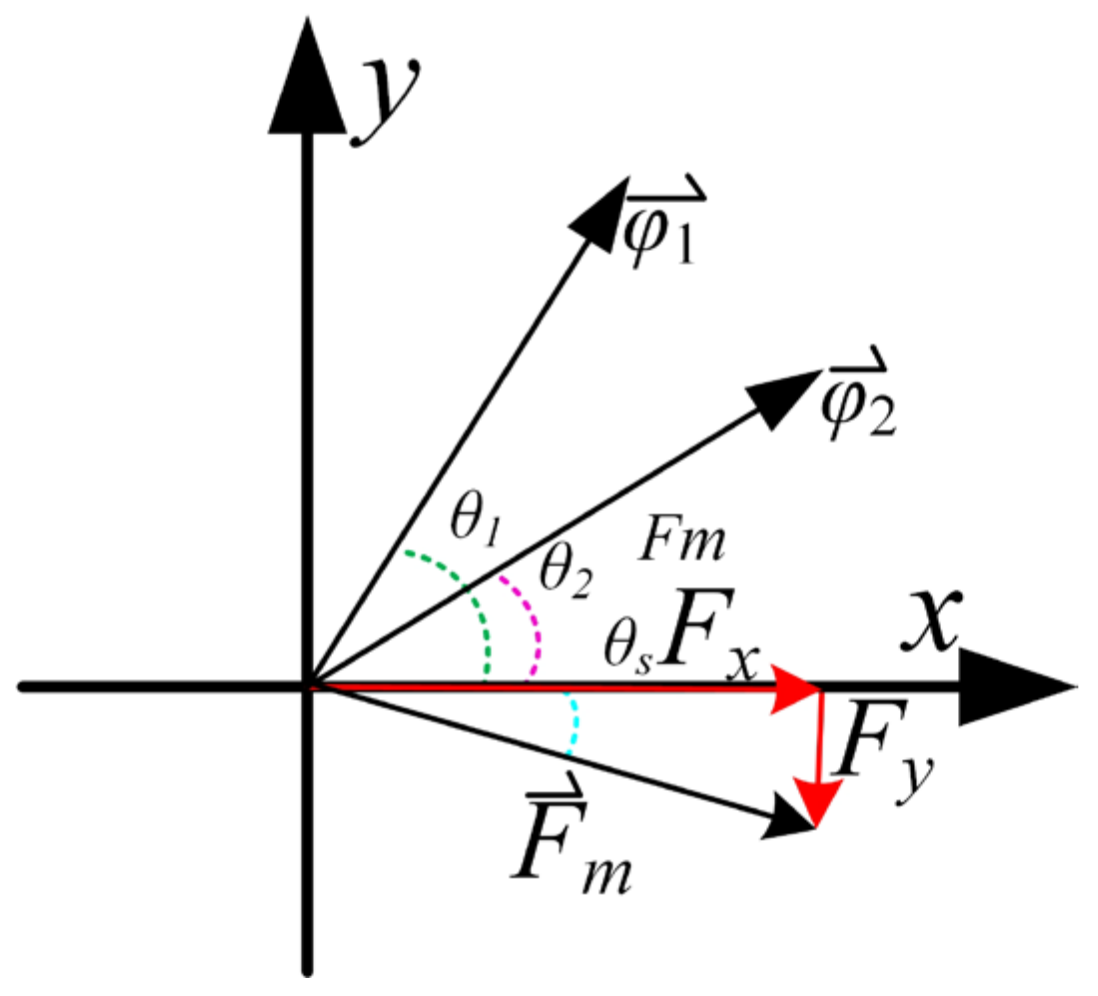

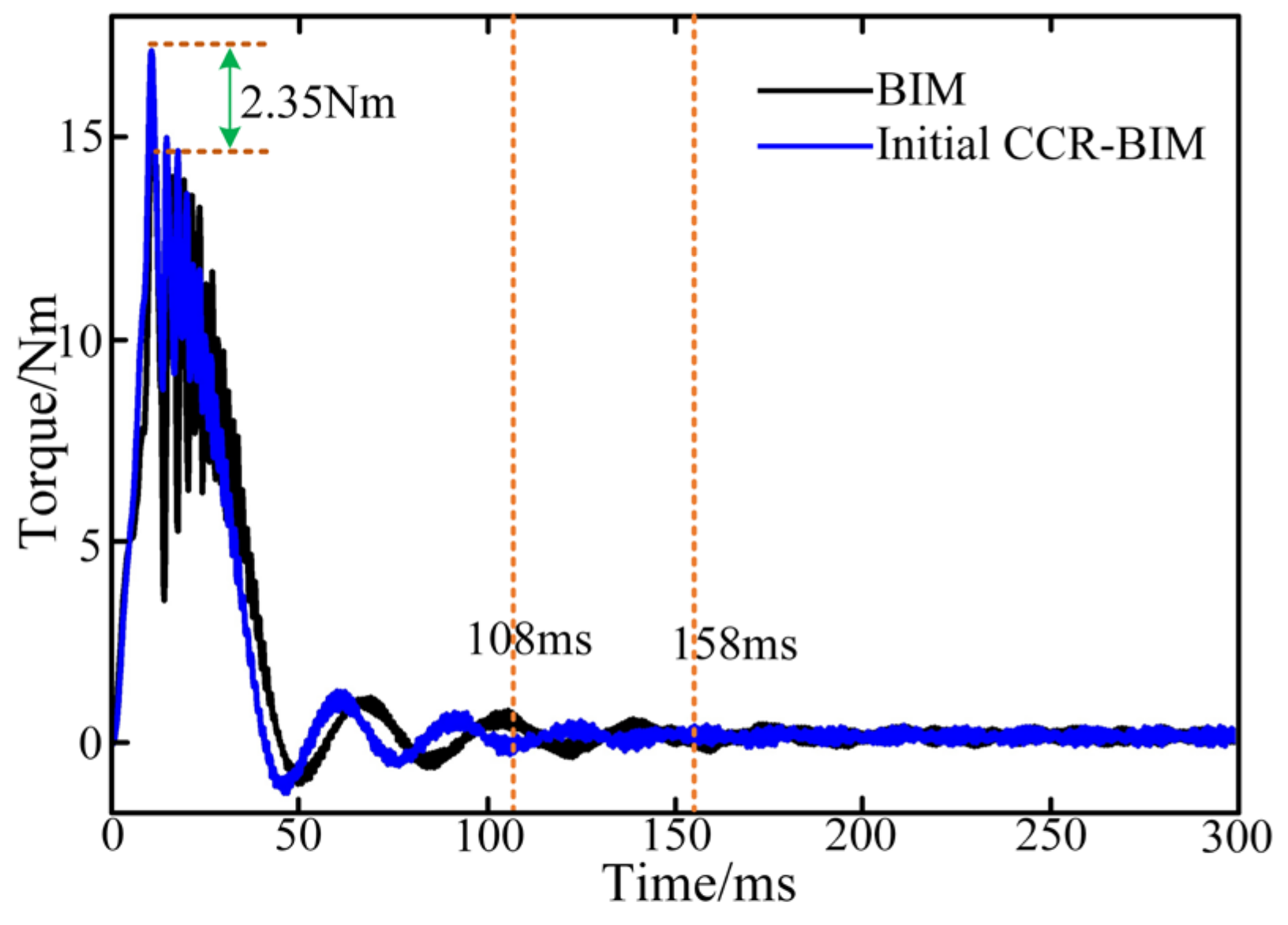

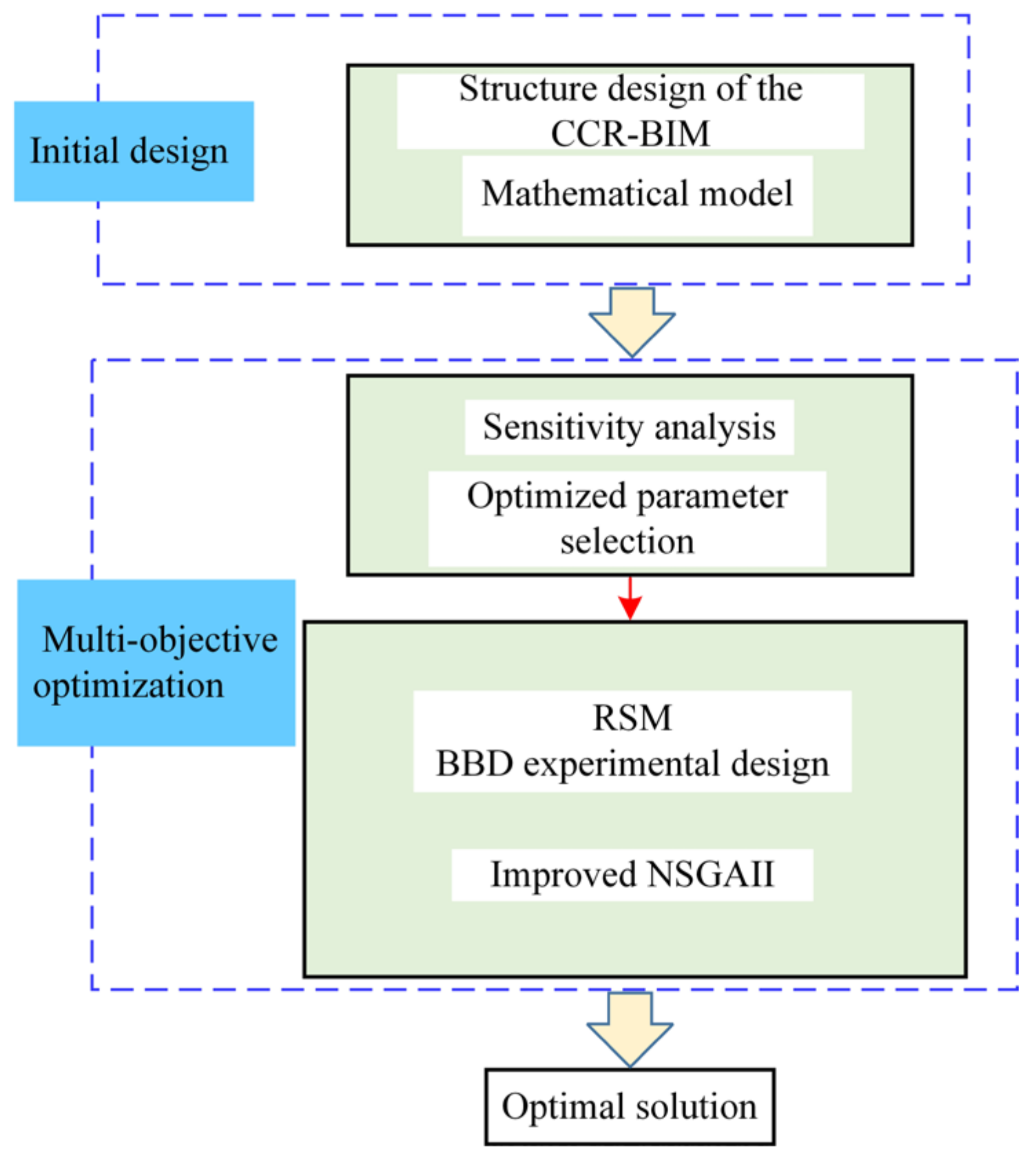

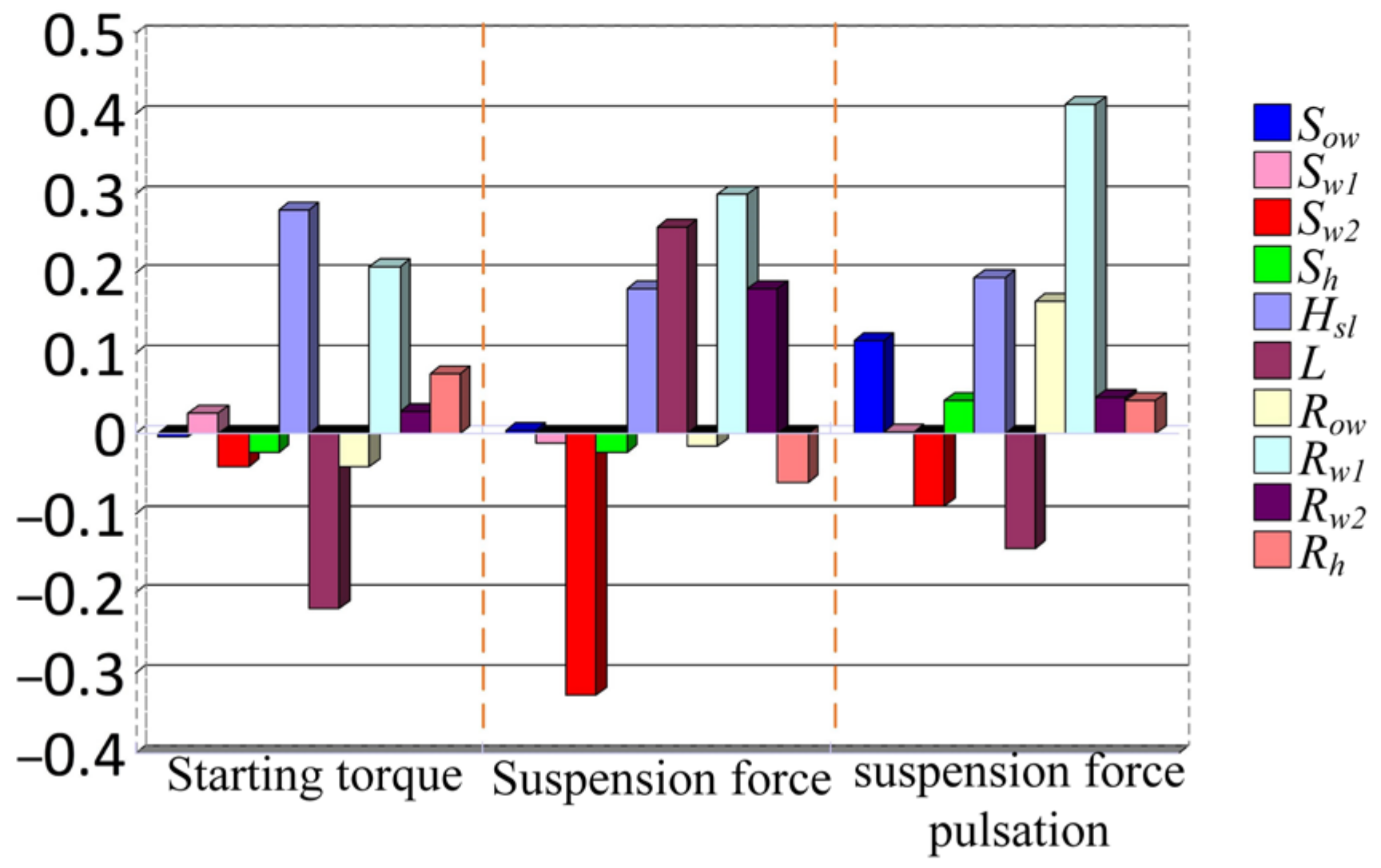





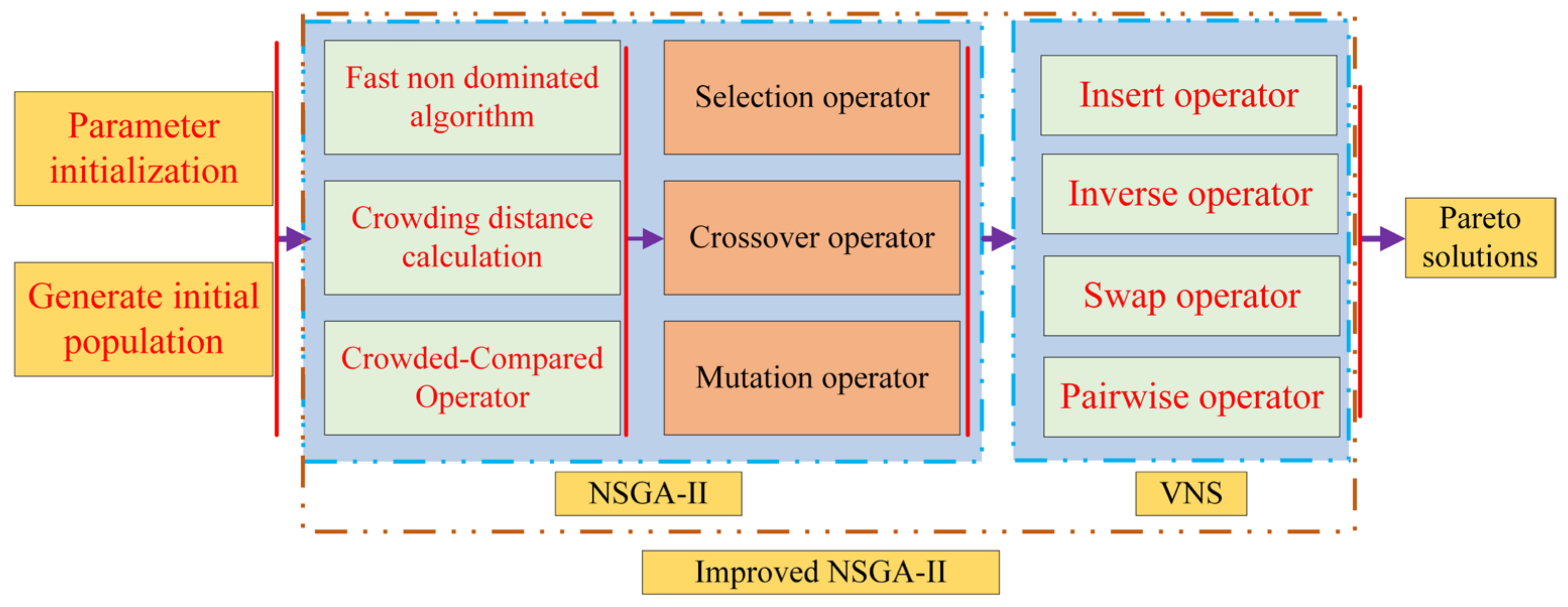
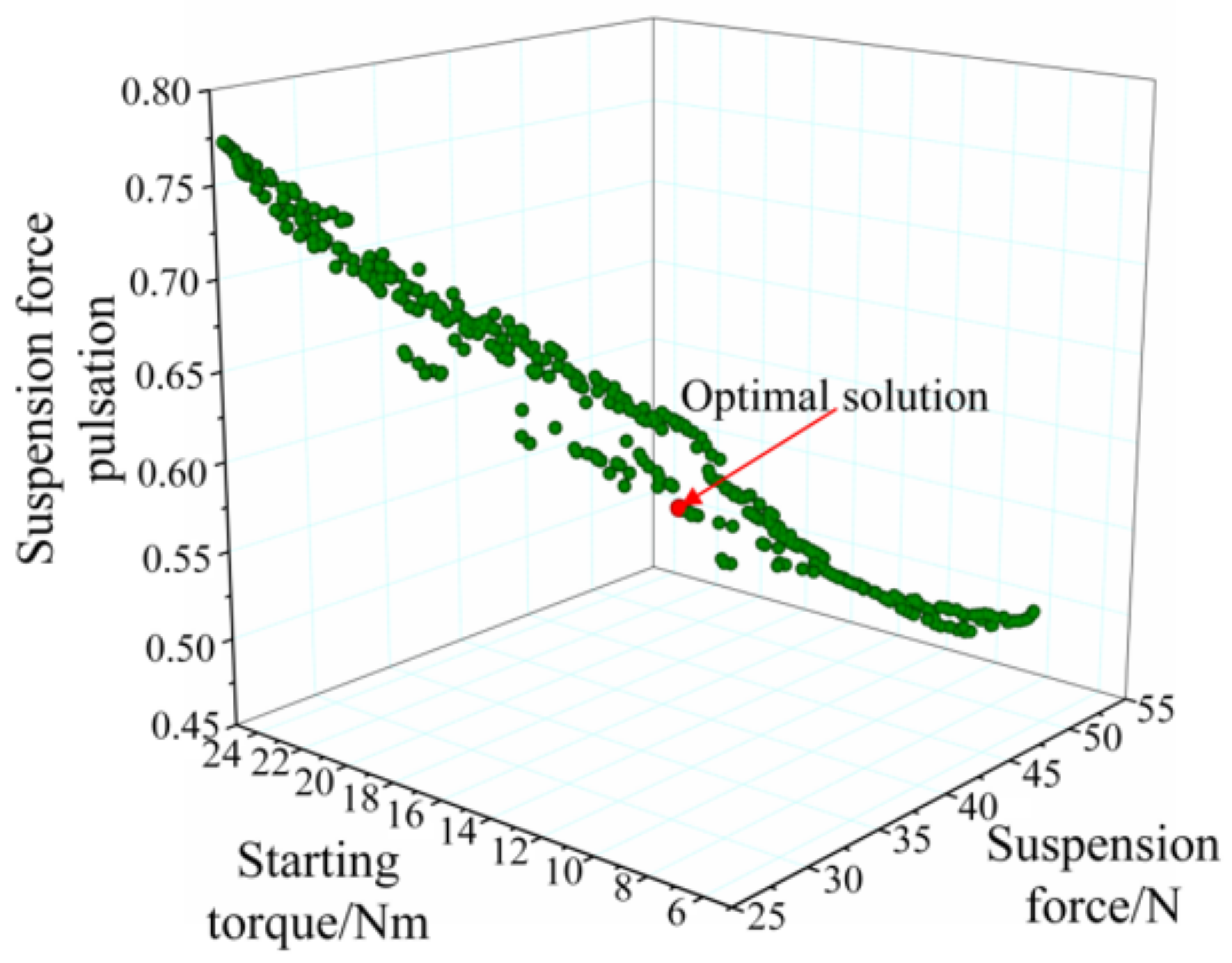
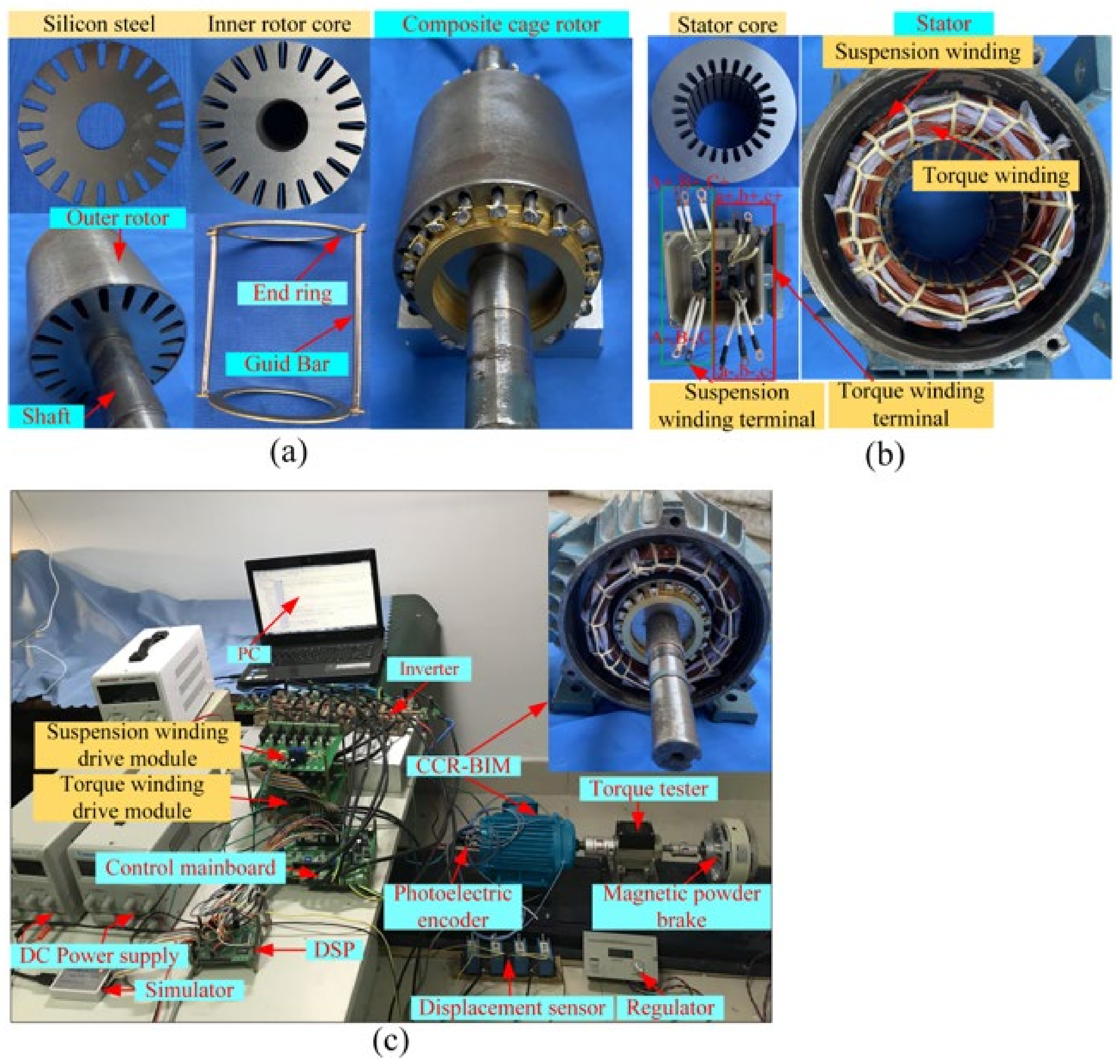

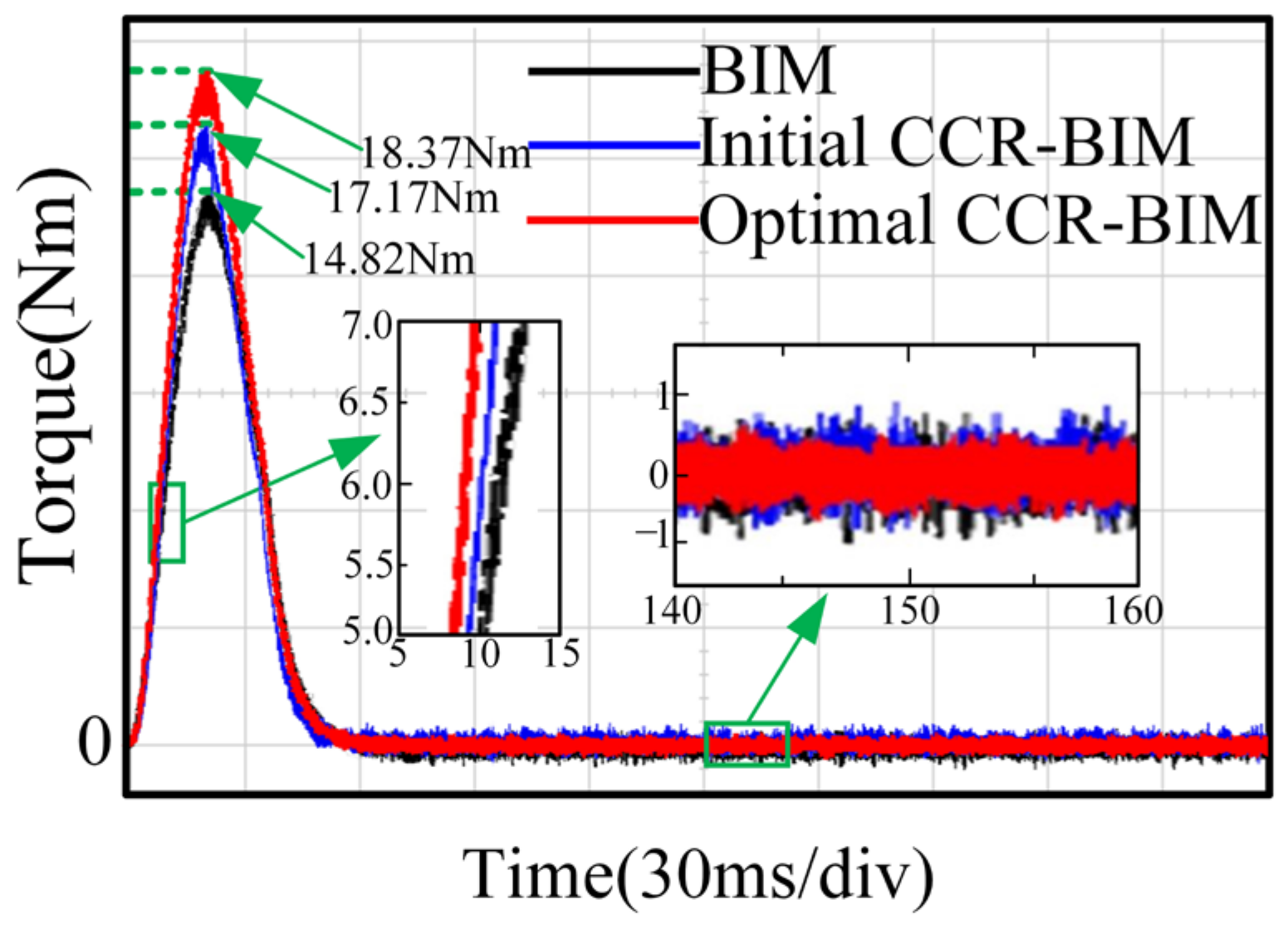


| Parameter Name | CCR-BIM | BIM |
|---|---|---|
| Rated power | 1.8 kW | 1.8 kW |
| Rated speed | 3000 r/min | 3000 r/min |
| Rated efficiency | 0.82 | 0.80 |
| Rated current of torque winding | 3.0 A | 3.0 A |
| Rated current of suspension force winding | 0.5 A | 0.5 A |
| Inner diameter of stator | 65 mm | 65 mm |
| Outer diameter of stator | 122 mm | 122 mm |
| Air gap | 0.3 mm | 0.3 mm |
| Motor inertia | 7.69 g·m2 | 7.67 g·m2 |
| Turns of torque winding | 60 | 60 |
| Turns of suspension force winding | 50 | 50 |
| Silicon steel material | B50 | B50 |
| Symbol | Design Variable | Initial Value | Range |
|---|---|---|---|
| Sow | Notch width of stator | 2.5 mm | 2.0–3.0 mm |
| Sw1 | Slot width of stator | 4.5 mm | 4.2–4.8 mm |
| Sw2 | Slot bottom width of stator | 6.0 mm | 4.8–7.6 mm |
| Sh | Slot depth of stator | 8.2 mm | 7.6–8.8 mm |
| Hsl | Thickness of outer rotor | 1.8 mm | 1.7–2.0 mm |
| L | Core length of composite rotor | 80.0 mm | 70–90 mm |
| Row | Notch width of inner rotor | 0.8 mm | 0.6–1.1 mm |
| Rw1 | Slot width of inner rotor | 3.2 mm | 2.8–4.4 mm |
| Rw2 | Slot bottom width of inner rotor | 1.7 mm | 0.8–2.6 mm |
| Rh | Slot depth of the inner rotor | 7.0 mm | 6.5–7.5 mm |
| Objectives | Traditional BIM | Initial CCR-BIM | Optimal CCR-BIM | Optimization Effect |
|---|---|---|---|---|
| Tst | 14.96 Nm | 17.31 Nm | 18.40 m | ↑6.29% |
| Favg | 36.22 N | 40.67 N | 43.26 Nm | ↑6.36% |
| Fpul | 0.79 | 0.62 | 0.53 | ↓14.51% |
| Objectives | Traditional BIM | Initial CCR-BIM | Optimal CCR-BIM | Optimization Effect |
|---|---|---|---|---|
| Tst | 14.82 Nm | 17.17 Nm | 18.37 Nm | ↑6.98% |
| I2 (Favg) | 0.5 A | 0.46 A | 0.43 A | ↓5.45% |
| Dmax (Fpul) | 72.4 μm | 52.3 μm | 42.6 μm | ↓18.54% |
Disclaimer/Publisher’s Note: The statements, opinions and data contained in all publications are solely those of the individual author(s) and contributor(s) and not of MDPI and/or the editor(s). MDPI and/or the editor(s) disclaim responsibility for any injury to people or property resulting from any ideas, methods, instructions or products referred to in the content. |
© 2023 by the authors. Licensee MDPI, Basel, Switzerland. This article is an open access article distributed under the terms and conditions of the Creative Commons Attribution (CC BY) license (https://creativecommons.org/licenses/by/4.0/).
Share and Cite
Lu, C.; Yang, Z.; Sun, X.; Ding, Q. Design and Multi-Objective Optimization of a Composite Cage Rotor Bearingless Induction Motor. Electronics 2023, 12, 775. https://doi.org/10.3390/electronics12030775
Lu C, Yang Z, Sun X, Ding Q. Design and Multi-Objective Optimization of a Composite Cage Rotor Bearingless Induction Motor. Electronics. 2023; 12(3):775. https://doi.org/10.3390/electronics12030775
Chicago/Turabian StyleLu, Chengling, Zebin Yang, Xiaodong Sun, and Qifeng Ding. 2023. "Design and Multi-Objective Optimization of a Composite Cage Rotor Bearingless Induction Motor" Electronics 12, no. 3: 775. https://doi.org/10.3390/electronics12030775
APA StyleLu, C., Yang, Z., Sun, X., & Ding, Q. (2023). Design and Multi-Objective Optimization of a Composite Cage Rotor Bearingless Induction Motor. Electronics, 12(3), 775. https://doi.org/10.3390/electronics12030775









